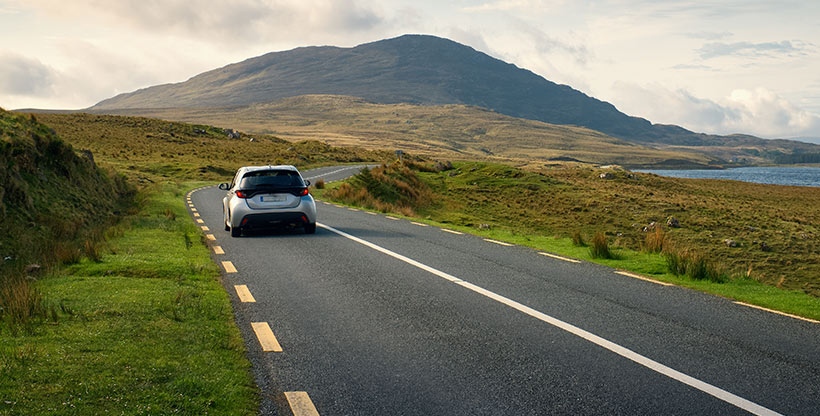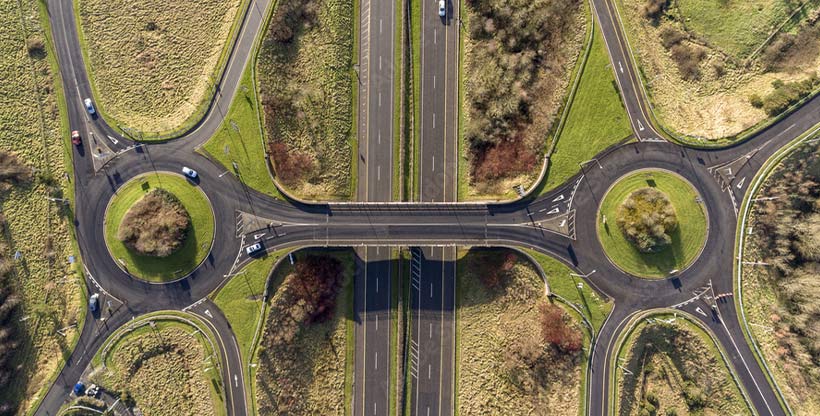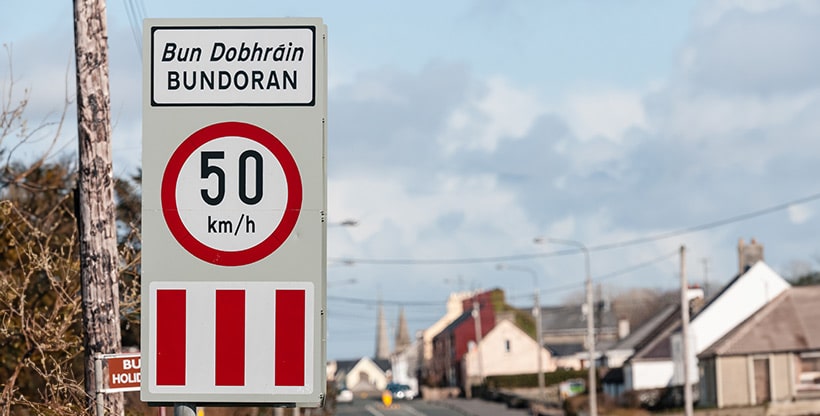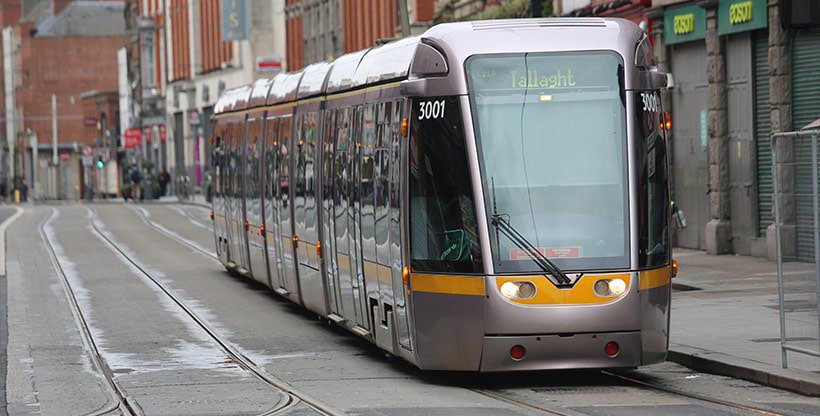Individuals
An Expat’s One-Stop Guide to Driving in Ireland

Steering Through Spuds and Sheep: Tips for Driving, Requirements, Traffic Rules, and Beyond
As you embark on your adventure through Ireland’s scenic landscapes and picturesque roads, or the bustling city streets, let us help you get a grip on the local driving rules and customs for a safe journey. As an expat, mastering the Irish way of the road is your ticket to a seamless travel experience.
This one-stop guide equips you with an understanding of the driving and insurance requirements, accepted driver’s licences, and age restrictions for drivers. We explain Penalty Points and NCT. You’ll even find links to official resources. We’ll tackle the driving rules, tricky roundabouts, tolls, and give you parking and driving tips. We’ll even cover the essential differences between driving in Northern Ireland vs. the Republic of Ireland, and the US. All of these might be quite different from what you’re accustomed to.
Keep reading to discover everything you need to know about driving in Ireland as an expat:
Navigate to Key Sections of This Guide:
- Requirements to Drive
- What is the National Car Test (NTC)?
- Traffic Laws
- Additional Driving Rules
- Penalty Point System
- Tips for Driving in Ireland
- Driving in Northern Ireland vs. the Republic of Ireland
- Driving in Ireland vs. the US
Depending on where you’re coming from, driving on Irish roads is an adventure filled with new challenges. From driving on the left side of the road to getting used to manual transmission cars, deciphering the colorful road signs and Gaelic place names, this guide is your handbook to adapting swiftly and conquering the Irish roads like a seasoned local.
Whether you’re planning to commute, set off on a scenic road trip around Ireland to explore the enchanting countryside, or simply run daily errands, understanding these details will let you have a safe and enjoyable driving experience in Ireland.
What are the Requirements to Drive in Ireland?
Driving in Ireland involves understanding and complying with specific requirements to ensure you’re legally allowed to take the wheel. This section breaks down these prerequisites into clear, manageable categories.
Driver’s Licence Requirements
Similar to many other countries, it’s mandatory to have a valid driver’s licence in Ireland. The rules for using a foreign driver’s licence in Ireland vary based on the country of issuance, especially for expats who plan to stay for an extended period. To obtain an Irish driver’s licence, you typically need to pass a driving test, a theory test, and, in some cases, exchange your foreign licence. Here’s a breakdown of the different scenarios:
- EU/EEA Driver’s Licence: If your licence is from an EU or EEA country, you can drive in Ireland as long as your licence is valid. There’s no need to exchange it for an Irish one unless it expires or you decide to do so voluntarily.
- UK Driver’s Licence (Post-Brexit): Post-Brexit, UK licences are subject to new regulations. You can use your UK licence for a certain period in Ireland, after which you need to exchange it for an Irish one. UK licence holders can just exchange their licence for an Irish licence, and are not required to do a driving or theory test.
- Non-EU/EEA Driver’s Licence: Those with licences from outside the EU/EEA can drive in Ireland for up to 12 months. Beyond this, you are required to exchange your licence for an Irish one upon becoming normal resident. This may require you to provide proof of residency, and pass a driving and theory test, depending on your home country. See the resources below for the official site links to check if your country is known as a Recognised States, where the driver can just exchance their licence for an Irish one.
- International Driving Permit (IDP): An IDP can accompany your non-EU/EEA licence, aiding in its understanding by local authorities. While useful for short stays or as a translation tool, it doesn’t replace the need for an Irish licence for long-term residents.

Driving Tests for Licence Conversion
If your licence is not from an EU/EEA country, you may be required to take a written theory test and a practical driving test to obtain an Irish driver’s licence. The theory test covers a range of topics, including road signs, rules of the road, and safe driving practices. The practical test assesses your driving skills, including vehicle controls, and the ability to safely navigate Irish roads.
Resources
Get started with exchanging your foreign licence on the official NDLS website.
Find the official details about the Irish driving test on the RSA website.
Prepare and book your driver theory test on the DTT site.
Apply for a driving licence with the NDLS here.
Car Insurance Requirements
Having car insurance in Ireland is a legal requirement. Various car insurance policies are available, ranging from minimal to full coverage:
- Third Party Fire & Theft insurance covers the minimum legal requirement to drive in Ireland, damage to other vehicles or property, as well as fire, theft, and injuries to other people in an accident you cause.
- Fully Comprehensive insurance, while more expensive, covers a broader range of scenarios, including damage to your own vehicle.
Challenges of Getting Insurance as an Expat
It is common that expats find it quite challenging to get car insurance in Ireland and have their international driving experience accepted along with foreign no claims bonuses. Unlike most insurers who turn a blind eye to your driving history outside Ireland, Clements is one of the only brokers who actively accepts no-claims bonuses from select countries and ensures they’re reflected in your premium.
Learn more about your car insurance options in Ireland, which are specifically tailored for foreign nationals and expats.
Beware of Ghost Brokers
When searching for car insurance, it’s important to be aware of the risk posed by ghost brokers, who are a significant problem in Ireland. These fraudulent individuals or groups sell fake or invalid insurance policies, often targeting people seeking affordable rates. They typically operate online, via classified ads, or social media and may also use tactics such as cold calling or door-to-door sales.
Ghost brokers use deceptive practices like forging insurance documents or misrepresenting risk information to sell policies from legitimate insurers. The danger of ghost brokers lies in the fact that customers only realize the fraud when they need to make an insurance claim, finding themselves without valid coverage.
To safeguard against ghost brokers, exercise caution and conduct thorough research before committing to a policy. Be wary of offers that seem too good to be true, especially those with exceptionally low rates. Always verify the credentials of an insurance broker, ensuring they are registered with the Central Bank of Ireland.
If you suspect you’ve encountered a ghost broker, report the incident to the Gardaí (Irish police) and the Central Bank of Ireland here.
Age and Health Requirements
The legal age to drive a car in Ireland is 17. However, rental car companies often have their own age requirements, usually requiring drivers to be at least 21 or 25 years old. Additionally, certain health conditions may require you to notify the National Driver Licence Service (NDLS) and could impact your ability to drive.
Resources
Find the most up to date driving licence categories and minimum age requirements on the RSA.ie website.
See the medical report requirements on the NDLS.ie website.
Vehicle Registration and Roadworthiness
All vehicles in Ireland must be registered and have a valid motor tax. Additionally, cars over four years old must pass the National Car Test (NCT) to verify that they meet safety and environmental standards. This test checks various aspects of the vehicle, including brakes, emissions, and lights, and must be repeated at regular intervals.
We look at the NCT in more detail below:
What is the National Car Test?
The National Car Test (NCT) is a mandatory vehicle inspection program in Ireland that ensures cars over a certain age meet essential safety and environmental standards. It is similar to the MOT test in the United Kingdom or the vehicle emissions test in some US states.
The primary goal of the NCT is to reduce the number of road accidents resulting from vehicle defects and to lower emissions. The frequency of the NCT depends on the age and type of the vehicle.
- Cars that are four years old must undergo their first NCT and are then required to take the test every 2 years
- Once a car turns 10 years old, the test becomes an annual requirement
- If your car is between 30 and 39 years old and you are not using it for commercial purposes, you need to take the test every 2 years

NCT inspections are carried out at designated testing centres around the country and take approximately 30 minutes.
To pass the NCT, your car should be in good working order. Areas of inspection include brakes, tires, lights, suspension, steering, emission levels, as well as seatbelts and the vehicle’s bodywork.
Ensuring these parts are well-maintained not only helps in passing the test but also contributes to safer driving. You can prepare by checking your vehicle lights, tyre tread depth, and fluid levels and by addressing any dashboard warning lights.
If you are importing a car from another EU country and you have a current EU Roadworthiness Certificate, you can continue to use it in Ireland until it expires. We go into more detail here about importing your car to Ireland.
Following the test, you will receive an NCT certificate if your vehicle passes. This certificate is required for tax renewal.
What if You Fail the NCT?
If your car fails, you will receive a report detailing the reasons. You must repair these issues, book a re-test within 21 days, and the re-test must be completed within 30 days of the original test.
It’s important to note that driving a vehicle without a valid NCT certificate on the roads of Ireland is illegal and can result in fines and penalty points.
Resources
For more detailed information on the NCT, including guidelines on preparing for the test and scheduling a test for your vehicle, head over to the official NCT website. This resource provides comprehensive insights into the testing process and valuable tips to ensure your vehicle meets all the standards for safe and compliant driving in Ireland.
Navigate to Key Sections of This Guide:
- Requirements to Drive
- What is the National Car Test (NTC)?
- Traffic Laws
- Additional Driving Rules
- Penalty Point System
- Tips for Driving in Ireland
- Driving in Northern Ireland vs. the Republic of Ireland
- Driving in Ireland vs. the US
Traffic Laws in Ireland
Understanding and adhering to traffic laws in Ireland is crucial for safe and lawful driving. Irish traffic laws might have some notable differences from those in other parts of the world, which may be even more challenging if you are driving in Ireland for the first time.
- Roundabouts: One of the key differences is the use of roundabouts. In Ireland, you give way to vehicles already on the roundabout, traffic coming from the right, and follow the roundabout in a clockwise direction.
- Red Light Rules: A red light means stop in Ireland. However, unlike some US states, you cannot turn on a red light in Ireland.
- Toll Roads: Ireland has several toll roads, particularly around major cities and on inter-urban routes. You can pay these tolls at booths, with some accepting cash and card payments, or via an electronic tag system.
- Speed Limits and Signs: Speed limits and road signs in Ireland are in kilometers per hour instead of miles per hour. See for more on speed limit variations and signs below.

Additional Driving Rules in Ireland
Understanding the finer nuances of driving rules in Ireland can make your experience safer and more enjoyable. Here, we delve into additional common driving rules that are essential to know for navigating Irish roads.
Seat Belt Usage
In Ireland, wearing seat belts is mandatory for all occupants of a vehicle, both in the front and back seats. This rule is strictly enforced, and failure to comply can result in penalty points and fines.
Speed Limit Variations
Speed limits in Ireland vary depending on the type of road and area. The current general speed limit is:
- 30km/h (19mph) in specially designated areas such as Schools
- 50 km/h (31 mph) in built-up areas (towns and cities)
- 80 km/h (50 mph) on national roads (single carriageway)
- 100 km/h (62 mph) on dual carriageway national roads
- 120 km/h (75 mph) on motorways
Be vigilant for speed limit signs, especially when transitioning between different types of roads. There may be specific lower limits in place on certain roads or in certain areas.
New speed limits coming: By the end of 2024, Ireland will roll out new speed limit laws. Due to a significant increase in road deaths in the last year, the plan is to lower the speed limits on Irish roads to 80km/h on dual carriageway national roads, 60km/h on rural roads, and 30km/h in built-up areas.
Cell Phone Usage
Using a mobile phone while driving is illegal in Ireland unless you have a hands-free system. The law includes texting, scrolling through playlists, or any other hands-on use of a phone. Violating this rule can result in fines and penalty points.
Driving Under the Influence
Ireland has strict laws against driving while intoxicated, so much so that most Irish residents will not drive after even one drink. According to the Irish Statute Book, the legal drinking and driving limit in Ireland is 0.05% BAC (blood alcohol content). For reference, that is lower than the 0.08% BAC legal limit in the U.S. and many other countries. For professional, learner, and novice drivers, the limit is even lower at 0.02%.
As a rule of thumb, for every one drink, your BAC goes up by about 0.02%. Meaning about 3 standard drinks will put you over 0.05%. However, remember that each person processes and reacts to alcohol differently so you can’t rely on that – it’s safest to just NOT DRINK before driving!
The penalties for drinking and driving can be severe, including fines, penalty points, and even imprisonment.
Right of Way Rules
As a general rule, the right of way is given to traffic approaching from the right, especially at uncontrolled intersections and roundabouts. However, always look for and obey right-of-way signs at intersections.
Special Licence Plates
Ireland employs a distinct system of licence plates to denote the experience level of drivers. This system includes:
- L Plates: Designated for learner drivers. These plates indicate that the driver has not yet passed their driving test
- N Plates: For novice drivers who have passed their driving test but are in their first two years of driving
- R Plates: Used exclusively in Northern Ireland, these plates signify a restricted driver who is subject to a lower speed limit
Rules of the Road Resource:
Download the official Rules of the Road from the Irish Road Safety Association website.
How Does the Penalty Points System Work?
Ireland’s Penalty Points System is in place to promote safer driving and reduce road fatalities and serious injuries. It penalizes drivers for committing certain traffic offenses.
- Drivers accumulate penalty points for numerous driving offenses, including speeding, using a mobile phone while driving, and not wearing a seat belt. These points are recorded on your driver’s licence and expire 3-years from the date they were added to the licence.
- The number of points depends on the severity of the offense. For example, speeding or driving while using a mobile phone may result in two or three points, while more serious offenses such as reckless driving or drink driving may result in four points.
Since these penalty points indicate risky driving behavior, accumulating them can lead to higher insurance premiums. Drivers who accumulate 12 penalty points within a 3-year period will have their driving licence suspended for 6 months. For learner permit holders and novice drivers (first two years holding a full driving licence) there is a lower threshold of 7 penalty points. - A fixed fine notice is also issued to the driver, which they must pay within 28 days. If they fail to do so, then the fine is increased and if payment has not been made after that, the driver is summoned to court.
- For drivers with a foreign licence a record will be created, and the penalty points recorded on that record. The driver is required to surrender his/her Irish or foreign driving licence to the National Driver Licence Service within 10 days of disqualification commencing.
The system is intended to be transparent and fair, with penalty points applied based on clear criteria. The goal is not to punish but to encourage drivers to adopt safer driving habits.
Resources
For more information on the penalty point system, visit the Road Safety Authority site to learn more about how it works, types of offenses, and statistics.
Navigate to Key Sections of This Guide:
- Requirements to Drive
- What is the National Car Test (NTC)?
- Traffic Laws
- Additional Driving Rules
- Penalty Point System
- Tips for Driving in Ireland
- Driving in Northern Ireland vs. the Republic of Ireland
- Driving in Ireland vs. the US
Tips for Driving in Ireland for Foreigners
Driving in Ireland presents unique challenges and experiences, especially for expats and foreigners. Adjusting to local driving conditions and regulations is essential to ensuring a safe and enjoyable journey on Irish roads.
Here are some tips to help you navigate Ireland’s roads more confidently, whether you’re behind the wheel for the first time or returning after a while:
- Practice Driving on the Left-Hand Side: If you’re used to right-hand driving, driving on the left can be disorienting. Practice in less busy areas or car parks to build your confidence, drive slow, pay extra attention to your right mirror as that’s where oncoming traffic will be first visible, and watch that left turn as you’ll be crossing oncoming traffic.
- Understand Irish Road Signs: Irish road signs may differ from those in your home country. They are broadly the same as in England, Scotland and Wales with some slight differences. Some examples:
- The speed signs in Ireland are round in shape compared to rectangular in the US.
- Another big difference is that Irish and English wording appear on the road signs here.
- Place name signs for towns, cities, and places of interest/tourist sites are also in both languages.

Check out the Irish Dept. of Transportation’s Traffic Signs Manual to familiarise yourself with signs indicating speed limits, directions, and warnings for safe navigation. Another good source for road signs in Ireland is the National Driving School’s guide (PDF).
- Watch the Speed Limit Signs When Crossing Borders: Speed limit signs are the biggest priority to be aware of. In Ireland you drive over the border without really noticing anything, as there is no border control. The road signs all just change and speed limits displayed are all of a sudden in miles rather than kilometers.
- Learn Speed Limit Conversions: Ireland uses the metric system, so get used to converting speed limits from miles to kilometers per hour. Many cars have dual-unit speedometers to assist with this adjustment. Focus on round numbers for common speed limits, for example remember that 50 km/h is roughly 30 mph, 80 km/h is about 50 mph, and 100 km/h is roughly 60 mph. See the Speed Limit Variations section in this guide for more.
- Ensure Proper Licensing: Check the validity of your driver’s licence in Ireland. An International Driving Permit or exchanging your foreign licence for an Irish one may be necessary, especially for longer stays or residency.
- Find the Right Insurance Coverage: Be aware of the different types of insurance and stay vigilant against ghost brokers who sell cheaper but fraudulent policies. Companies like Clements can help you find legitimate hassle-free car insurance solutions for Ireland specifically designed for expats and foreign nationals.
- Gas Stations and Fuel Types: Gas stations are called “petrol stations” in Ireland. Gas stations in Ireland offer petrol (gasoline) and diesel. Unleaded petrol and diesel are widely available. Gas stations in urban areas are plentiful, but in rural areas, they can be sparse and almost none of them offer 24/7 service, so it is a good rule of thumb to refill your tank when it is half empty.
- In addition to petrol and diesel, Ireland is expanding its network of Electric Vehicle (EV) charging stations. For electric and hybrid vehicle owners, these stations offer convenient charging options.
To learn more about EV charging in Ireland, including locating a charging station near you, visit the Irish Electric Vehicle Association website. This resource provides valuable information on the accessibility and usage of EV charging facilities across Ireland.
- In addition to petrol and diesel, Ireland is expanding its network of Electric Vehicle (EV) charging stations. For electric and hybrid vehicle owners, these stations offer convenient charging options.
- Be Vigilant for Livestock & Pedestrians: Especially in rural areas, watch out for livestock and pedestrians who may be on the road where footpaths are absent.
- Know What to Do in Case of an Accident: In an accident, remain calm, ensure everyone’s safety, exchange information, and contact your insurance company. For the local procedures for reporting accident, visit the Garda’s website (Ireland’s national police and security service).
- Know Where to Park & Not Park: Parking in Ireland can be tricky. Avoid fines, clamping, or penalty points by paying close attention to the parking rules and signs:
- Watch those lines! Never park on double yellow lines or zig zag marks and follow parking times on white lines.
- You can park on a single yellow line, but only during specific times shown on parking sign.
- Bus or tram lanes, clearways, pedestrian crossings, footpahts are off-limits, unless explicitly allowed.
- No parking on motorways, not even on the hard shoulder.
- Pay attention to no-parking and restricted signs such as pay-and-display, disc parking, or free parking zones.
- Double parking is a no-no and comes with fines.
- Consider resident permits and visitor permits in residential areas.
- Adapt to Various Weather Conditions: Irish weather can be diverse, so adapt your driving accordingly. In winter, temperatures generally range between 4 to 8 degrees Celsius / 40 to 46 degrees Fahrenheit but can occasionally drop below freezing making driving more hazardous. Ensure your car is well-equipped, slow down, use headlights or fog lights, do not use cruse control, and be aware of black ice.
Driving in Northern Ireland vs. the Republic of Ireland
When comparing driving experiences between Northern Ireland and the Republic of Ireland, it’s a tale of two Irelands.

Side of the Road
Luckily both countries drive on the left side of the road.
Speed Limits
One of the most notable differences is in the measurement units for speed limits and distances:
- Northern Ireland, as part of the United Kingdom, uses miles per hour (mph) – typically 30 in towns, 60 outside, 70 on motorways
- The Republic of Ireland operates with kilometers per hour (km/h) – typically 50 in towns, 80 on single roads, 100 on national roads, 120 on motorways
Be extra cautious when crossing the border and adjusting to new signs and speeds.
See the Speed Limit Variations section in this guide for more details and the changes coming to speed limit laws in Ireland.
Road Signs
Road signage in Northern Ireland also adheres to the UK format, which can be distinct from the signs in the Republic of Ireland. This includes variations in symbols, colors, and designs.
For example,
- in Northern Ireland, warning signs typically use black symbols on a white background with a red border, following the UK format
- meanwhile, the Republic of Ireland uses yellow and black for its warning signs
Urban Driving
The urban driving experience in Norther Ireland vs. The Republic of Ireland also differs significantly.

In Dublin, has the presence of tram lines and bus lanes adds another layer of complexity to city driving, with specific rights-of-way for public transport. Tram lines for the LUAS system often run alongside or intersect with regular traffic lanes. These trams have priority over other vehicles, meaning that when a tram is approaching or crossing, other traffic must yield.
Navigating Dublin’s bustling streets requires more than just a good map. Be sure to keep an eye out for the city’s dedicated bus lanes—zones reserved exclusively for public transport during specific hours. These lifelines for commuters can be easily identified by their clear markings and signage, and typically operate during peak traffic times, often in the mornings and evenings, to help buses zip past gridlocked cars and keep Dublin running smoothly.
On the flipside, Belfast’s traffic flow and regulations are closer to those in other major UK cities. One-way streets are common and require attention to signage to avoid entering against the flow of traffic. Controlled junctions, which may include roundabouts and intersections with traffic signals, require an understanding of UK-specific rules, such as giving way to traffic from the right on roundabouts.
Tolls
Toll roads are also common in the Republic of Ireland, particularly on major routes, while Northern Ireland, following UK practice, does not have toll roads.
Driving in Ireland vs. United States
When comparing driving in the Republic of Ireland and the United States, there are several differences that stand out, such as:
| Republic of Ireland | United States | |
| Side of the Road | Left | Right |
| Driver’s Seat Position | Right side of the car | Left side of the car |
| Speed Limit Units | Kilometers per hour (km/h) | Miles per hour (mph) |
| Road Characteristics | Narrower and more winding, livestock or pedestrians on the road, especially in rural areas | Generally wider and often grid-patterned, including in urban areas |
| Vehicle Transmission | Manual transmission is more common | Automatic transmission is the norm |
| Urban Road Layout | Often narrow and congested streets, like in Dublin | Spacious urban layouts, typical in many American cities |
Conclusion
Driving in Ireland offers a unique experience filled with stunning landscapes and distinct road customs. From practicing driving on the left-hand side to familiarising yourself with local road signs and speed limits, it’s crucial to adapt to Irish driving norms for a safe and enjoyable journey.
Navigating the requirements for an Irish driver’s licence, complying with the National Car Test, and understanding the nuances of urban versus rural driving are all aspects of adapting to driving in Ireland.
Remember, the right car insurance is not just a legal requirement but a vital aspect of ensuring your financial protection and peace of mind on the road. For expats and foreigners living in Ireland, finding reliable and comprehensive car insurance can be a struggle.
Hit the Irish roads with peace of mind! Clements crafts flexible car insurance options, made just for expats and international drivers, keeping you well-protected on your Irish driving adventures. Visit our Car Insurance for Ireland page for more information, or request a quote today.
Enjoy your driving adventure in Ireland!
Navigate to Key Sections of This Guide:
- Requirements to Drive
- What is the National Car Test (NTC)?
- Traffic Laws
- Additional Driving Rules
- Penalty Point System
- Tips for Driving in Ireland
- Driving in Northern Ireland vs. the Republic of Ireland
- Driving in Ireland vs. the US
Prepare for Your Life Abroad
Browse our resources for expats to make the most of your life abroad. Some highlights:
- How to Get an International Driver’s License
- Best Scenic Drives in Ireland & UK
- What to Do With Your Stuff When Moving Internationally
- How to Rent Out Your House While Living Abroad
- Things to Do Before Moving Abroad
Related Helpful Content
Find tips, trends, and perspectives to help you confidently make decisions and navigate challenges internationally with peace of mind. Read how you can live, operate, and manage risks abroad.
An Expat’s One-Stop Guide to Driving in Ireland
Steering Through Spuds and Sheep: Tips for Driving, Requirements, Traffic Rules,
Tips for Driving in France: an Expat’s Guide
Driving in France is a great way to explore the country’s
12 Best Scenic Drives & Road Trips in the UK & Ireland
For expats in the United Kingdom or business travelers who wind